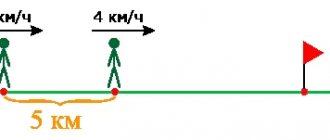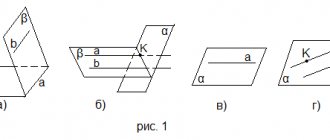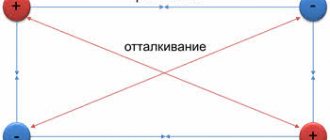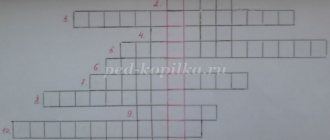Project "Musical Mathematics"
It is also interesting that when musicians perceive musical intervals, a number series automatically appears in their imagination, the segment of which is equal to a certain interval segment, i.e. a segment of numbers from 1 to 4 is presented - if they hear a fourth, from 1 to 7, if they hear a seventh, etc.
Rice. 6. Determination of intervals in P. Tchaikovsky’s work “Morning Reflection”
Thus, we are convinced that mathematics and music are very close sciences to each other. Without mathematics it is simply impossible to describe and play a piece of music. To be good at music, you need mathematical knowledge.
Chapter 2. Main research part
2.1. Survey methods and materials.
Following the theory of Pythagoras, numbers have absolute power over all events, over all living beings, which means that numbers rule music. In his works, he argued that music obeys a higher law (mathematics) and, as a result, restores harmony in the human body.
Let's try to establish a connection between numbers and music.
We researched the dates of birth of students in our class.
Dates of birth are a series of numbers. We put the dates on the sheet music. We assigned a step number to each note. Do -0, re-1, mi-2, fa -3, sol -4, la -5, si - 6, do-7, re-8, mi-9. Each person has their own sound range.
After listening to the sound, we noticed that some of them have
harmonious sound, the second part has a pronounced sound, and some are not at all in tune.
A connection has been established between the sound of the date of birth and
human abilities. To do this, we conducted a survey among students in our class. 30 people took part in it. We found out the direction of our guys' hobbies.
2.2.Results of the study.
The study found that:
in the first group, where the sound range sounds melodious, there were children with creative inclinations (they practice music, vocals, dancing, drawing);
in the second group, where the sound range has a pronounced sound, there were children who have a penchant for exact sciences (they are fond of chess);
in the third group, where the sound range was not at all in tune, there were children who were not interested in anything.
We conducted a study of the birth dates of classmates. The fact that music reflects the regularity of the number series and, as a consequence, there is a connection between the sound of birth dates and a person’s inclinations, is confirmed in our study. But to assert that the sound of the date of birth determines a certain type of human characteristics, a larger number of subjects is needed. If in a subsequent, deeper and more extensive study, our proposal is proven, this will give a person another way to discover himself, determine his occupation, and choose a profession where the individual’s potential will be most fully revealed.
Music and mathematics. Part I
Pythagoras A common stereotype about human nature is the division into “rational” physicists and “emotional” lyricists.
However, this is not entirely true. And music, which seems to be the embodiment of emotionality, can perfectly illustrate this.
“In the beginning there was a number,” - this is how you can start a story about music. The idea that it is possible to “verify harmony with algebra” is traditionally attributed to Pythagoras.
Since ancient times, music has been used in rituals and mysteries of different peoples, but before him no one had thought about why some musical harmonies are pleasant to the ear, while others sound harsh and irritating. For his experiments, Pythagoras used the monochord instrument, which, again according to tradition, he himself invented.
Although the instrument is called a monochord, it had two strings, one with a constant tone, and the other, using a simple mechanism, changed its sound at the will of the experimenter. By changing the proportional ratio of the two sounding strings, Pythagoras came to a conclusion fundamental to the entire history of music - proportion has a direct relationship to sound, and the quality of this sound is expressed by number!
Monochord of Pythagoras
This idea at that time was relevant not only to music, but also to the universe as a whole. For Pythagoras and his followers, the Pythagoreans, mathematics was a divine science that revealed the laws of beauty of the Universe, and music was also involved in the divine.
The whole world had proportions, which means it sounded. Today the idea of “harmony of the spheres” is perceived as a beautiful metaphor, but at that time it had a very specific meaning: the planets make sounds as they move, and these sounds relate to each other, like musical harmonies.
According to legend, Pythagoras was the only person who heard this “heavenly music”, but the rest are not able to perceive it, since it sounds all the time and people get used to it from birth.
A logical continuation of Pythagoras’ discovery was the idea of dividing consonances into consonances and dissonances. Without these concepts, the music of the European tradition could not exist in the form in which we know it.
Consonance is understood as consonance that evokes a feeling of peace, harmony, and stability. From a mathematical point of view, consonances are expressed by a simpler ratio of numbers: a perfect octave – 1/2, a perfect fifth – 2/3, a perfect fourth – 3/4.
Dissonances sound restless, harsh, create a feeling of incompleteness and are expressed in a more complex numerical ratio (for example, a major seventh - 8/15, a minor second - 15/16). The consequence of incompleteness was dependence - dissonance was used only in conjunction with consonance, that is, it required resolution.
With the development of music theory, the consonance of the octave and fifth was not questioned, but doubts arose at different times about the remaining consonances, or intervals. In addition, the system became increasingly more complex, because the more voices appeared in the compositions, the more complex the musical fabric became, the more complex relationships the consonances (not only the intervals themselves, but also the chords) entered into with each other.
All these nuances and disputes about them could have remained in the field of musical scholasticism, but ideas about consonance and dissonance were the cornerstone for musical practice, for the style and sound of works written under the influence of certain systems.
Starting from the Middle Ages, theoretical thought gradually followed the path of “rehabilitation” of dissonance, and then completely towards its “emancipation” (that is, understanding it no longer as dependent on consonance, but completely self-sufficient), which became a prerequisite for the development of music in the twentieth century.
For comparison, you can listen to several works written in different eras, with different understandings of the relationship between dissonance and consonance. These examples do not reflect all the stages in the development of this theoretical idea, but they give an idea of how different this music is.
Having the idea that sounds are added to intervals according to their proportional relationships, it was natural to begin attempts to somehow systematize all this. This is how the idea of a scale (a gradually decreasing/increasing sequence of sounds, understood in this case as steps - the analogy with a staircase is quite appropriate) and musical structure (a system that defines the principles of calculation according to which these steps were lined up relative to each other) appeared.
Thus, it became possible to create something like an alphabet, a list of available sounds in a scale or scale (these are not completely synonymous, but very close concepts), when combined, musicians obtained the expected sound results.
History knows several basic systems that were based on different principles, but they all had their own shortcomings and characteristics and were not universal. The main problem was that it was not possible to find such proportional relationships of sounds so that consonantal intervals at any height would sound “clean.”
This was especially important for keyboard instruments, since they, unlike strings, did not allow one to correct the sound of “dirty” intervals by ear during performance. The solution was found using temperament - narrowing or widening the intervals compared to the pure ones derived by Pythagoras.
This is how the equal temperament system appeared, which has dominated European music from the 18th century to the present day. Mathematical calculations helped: the octave was divided into 12 equal half-tone segments, which made it possible to completely unify the sound of all intervals at any height. This made it possible to compose works in different keys, and also to easily move, that is, modulate, from one to another, without fear of getting an unwanted bad-sounding consonance.
One of Bach's most famous works - “The Well-Tempered Clavier” - by its very name indicates that it was created in the era of the search for a universal system and a truly “good” sound of the “clavier”, that is, keyboard instruments.
There is no consensus on whether Bach wrote his works for the new equal temperament system or for one close to it, but the fact remains that this cycle became a powerful argument in favor of temperament.
According to many contemporaries of this reform, tempered intervals lost their beauty and “purity”, becoming “averaged.” However, there were many supporters who pointed out the convenience of practical application, and ultimately practice won.
It is possible to measure not only the relationships between sounds, but also the sound itself as a physical phenomenon, this is the field of musical acoustics. Sound is a wave, and the pitch of the sound depends on the frequency of vibration. There is a special unit for measuring this frequency - Hertz (Hz), named after the German scientist Heinrich Hertz. 1 Hertz is one oscillation per second.
If musical structure resolved the issue of relationships between sounds, then with the help of a new unit of measurement it became possible to establish the value of the tuning fork, that is, the standard of pitch used to tune instruments. The A sound of the first octave is usually used as a tuning fork.
At the moment there is no generally accepted standard, but the most common for academic music since the mid-19th century is A 440 Hz. In general, we can say that this value tends to increase. For example, the music of the French Baroque was performed at A 392 Hz, the music of Bach and most contemporaries - 415 Hz, the Viennese classics and early romanticism were characterized by a value of 430 Hz.
Now the tuning fork continues to rise - many orchestras are tuned to the 442-443 Hz standard. The highest value today is in Vienna, where they tune to 444-445 Hz. These features are directly related to the performance of works, because the higher the instruments are tuned, the more intense the music sounds, and the musicians have to strain more, especially singers.
This also affects perception: a higher setting gives the music a lighter color, a lower setting gives it a muted, dark tint. To compare the sound, you can listen to two versions of the same work by Bach, one in modern tuning, the other in the currently accepted baroque music for performance, where A corresponds to 415 Hz.
To be continued.
Elena Gutina, kultprosvet.by
Overtone or timbre
A very interesting property of sound is overtone.
Overtones are overtones that are part of the spectrum of musical sound. Translated from German, overtone means “high tone” or “high sound.” Now we’ll find out where this high-pitched sound comes from.
The entire string vibrates, you saw it yourself in the video about the guitar. But it turns out that each part of the string also vibrates and makes sound. Not as loud as the main tone, but quite noticeable.
Pythagoras also determined the principle by which overtones arise. It is as follows:
The first overtone arises from the vibration of half of the sounding body - in our case, the string. That is, if we pinch the string in the place where it is divided in half, the sound will be twice as high as the sound of a full string. This is the sound of the first overtone. But to hear it in its pure form, you need to use a special technique - harmonic.
Now we divide the string into 3 equal parts. One third of the string will give us the second overtone. Then we divide the string into 4 parts, we get the third overtone and so on.
This is what string vibration looks like: 1 – Whole string; 2 - its half - the first overtone; 3 - third part - second overtone, etc.
See how harmonics can be used to extract overtones:
Pythagoras established that the first overtone sounds one octave higher than the fundamental tone. The second overtone sounds higher than the first by a fifth; the third is higher than the second by a quart; the fourth is higher than the third by a major third. Then there will be minor thirds, then major and minor seconds. This is what the overtone series looks like from note to:
The timbre of the instrument and voice depends on the set and relative volume of overtones. It is thanks to timbre that we can distinguish the sound of a flute from the sound of a harp, the sound of a piano from the sound of a trumpet.
Informative
Overtones are also called harmonics. Guitarists often use harmonics as an artistic element in their playing.
There are also masters who weave harmonics into their playing so skillfully that it is not immediately clear how many instruments sound. Listen to how Jaco Pastorius skillfully uses harmonics on his bass guitar:
Sound frequency or pitch
Let's imagine a guitar: the thickest string is not stretched very tightly, plucking it produces a low sound, similar to the buzzing of a bumblebee. And if we pluck the thinnest string, which is stretched much tighter, the sound will turn out high, similar to the squeak of a mosquito. The more often the body producing the sound vibrates, the higher the sound will be. In this case, a body can be called any object that produces sound - be it a balalaika string or a drum membrane.
The pitch of sound in physics is called frequency and is measured in hertz (the number of vibrations per second). The frequency of sound in music is called pitch. Not a single musician in the world will understand what pitch a note conveys if it is not located on the staff. Read more about how sounds of very different pitches coexist on the five lines of the staff, here.
Informative
Interestingly, we are always led to think that sound is flat, but its diagram looks like this:
However, science has long known that sound is a wave. This means that the sound is three-dimensional and is a spiral, but not exactly the way you imagined it.
The English scientist Robert Hooke proved back in the 17th century that the pitch of sound is determined by the frequency of vibrations, and he was also the first to make an interesting experiment:
Hooke took a metal plate, poured flour on it and began to excite the plate with a violin bow. The flour on the plate took on a shape resembling a snowflake or ornament.
Nowadays, this experiment is much easier to do: a powerful speaker is placed under the plate, and then the frequency of the sound is changed. The result of the experiment is lace patterns on the sand, which is on the plate:







